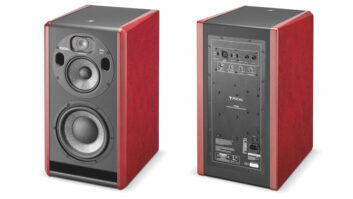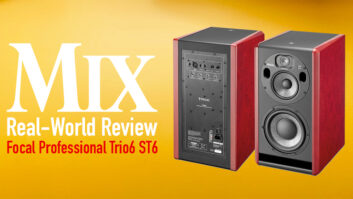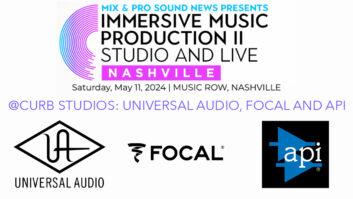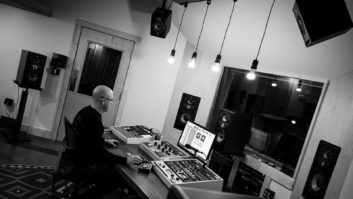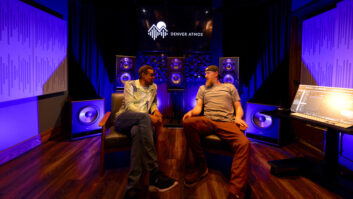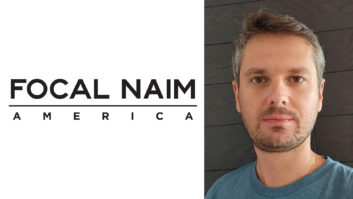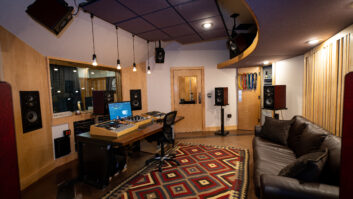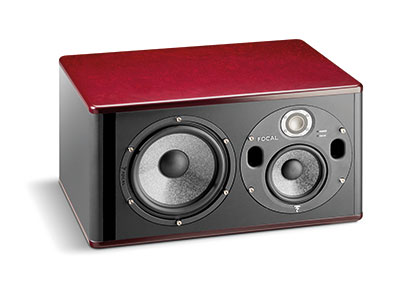
Focal’s studio monitors are a relatively new division of the company with a principal focus on audiophile, install, consumer and automobile transducers. Nonetheless, Focal has made a name quickly with a range of models from the affordable from the affordable Alpha50 starting at $299 each, up to the SM9 at $3,795 each. Beyond that is the Grande Utopia passive monitor favored by some mastering houses, which can cost as much as a Porsche 911 Carrera S once you buy the amps.
The Trio6 Be is a three-way system in a front-ported cabinet available in textured gray or optional Red Burr-Ash natural wood finish. Dimensions of the 0.86-inch (22mm) reinforced cabinets are 520x278x360 mm. At 44 pounds each, you’ll need a sturdy stand or console/tabletop to hold these adequately.
Focal’s thinking is a bit different when describing a three-way because of the Focus mode. Rather than calling the components woofer/midrange/tweeter, the company prefers subwoofer/woofer/tweeter. The active sub is an 8-inch composite, the midrange a 5-inch composite, and the tweeter a pure Beryllium inverted dome. The woofer/tweeter can rotate for vertical or horizontal orientation of the monitors. For this review, horizontal use made more sense, so I left them as is.
Focus mode is the same concept first found in the pricier SM9. Because the cabinet is internally sealed in a way that isolates the sub, the user can switch between a proper three-way and two-way monitor at the flick of a footswitch (not supplied). When in two-way Focus (90 to 20k Hz, ±3 dB), the woofer and tweeter are in play alone, and the crossover is changed to reflect the preference. In three-way Focus (35 to 40k Hz, ±3dB), the sub is engaged, which brings in the lower octave and a half. The switch is silent and fast, which gives you the ability to A/B quickly. The tuning between modes is well done with nothing sonically startling, just a pleasant and easy jump between a full-range and LF limited monitor. It’s a great way to work. For example, Focus allowed me to drop the low end to check electric guitars and other midrange-y mix elements without the added boom.
Amplification is 200 watts for the sub, 150W for the woofer and 100W for the tweeter. On the rear is an XLR input, +4dBu/-10dBV sensitivity switch, and variable LF, LMF, and HF EQ set at 250 Hz (shelving), 160Hz Q=1, and 4.5 kHz (shelving), all variable +3/-3 on a rotary detented pot. Also on the back are the ¼-inch inputs for the latching footswitch. I used a Boss FS-FL that I bought for $29.95 at Sweetwater.
Making Tracks
I first placed the Trio6 Be monitors in Blackbird Studio A, and after a time, they sounded loud, well-balanced and full range. At first listen though, the bottom end was tight and unimpressive. As I’ve experienced in the past, a break-in period is 100-percent necessary to allow the monitors to open up, so I parked them in another studio and let time work its magic. After a few weeks, it was a different experience. The bottom end bloomed, and I could better hear the benefit when using Focus.
Next, I put them into Studio I, a smaller production room that isn’t as acoustically adept as A. Here, the EQ on the rear of each speaker allowed me to dial them in correctly. Because the Studio I control room has access to the shared Studio A live room, I used them on tracking and overdub sessions. When listening to music over a range of styles from rock to country, to indie pop, they gave me the confidence I needed when fine-tuning EQ.
In Studio I, there’s no console, so I’m used to mixing and matching preamps, EQs and compressors from rackmount to 500 Series units of various styles and type. When getting kick drum sounds, I used a vintage 1073 EQ boosting 56 Hz, notching out 330 or 390 Hz, then adding a touch of 3.9 or 4.7 kHz for beater click—it was sonically beautiful and full-bodied. On another date, I used a Manley Massive Passive with the same formula, and again it sounded delicious, complete and just what the kit needed to rock the low end.
On other tracks, I was able to get great sounds on acoustic and electric guitar, vocals, and hand percussion. The ease of getting a great sound when you know the instrument, player and signal chain is solid is something I look for during a monitor review—that and perspective. If everything is right and you’re still struggling, or it doesn’t translate after, it’s probably the monitor. The Trio6 never let me down.
Because we split the feeds to two control rooms when we track at the Academy, I also have the luxury of immediately walking into another control room and hearing the tracks in another environment, usually on ATCs. The perspective during tracking and the next day in other studios cutting overdubs always translated perfectly.
If I had one complaint it has to do with the Euro-stipulated auto-shutoff feature. You can’t turn it off or extend the time, and I got stung repeatedly. I know this is the “green” thing to do but it’s always a surprise when you take a break and the speakers are off when you return. They do come back after audio is introduced but it takes more dB than you’d think.
In Focus
The Trio6 Be is a high-end listening experience. They are well-balanced low to high, with the Beryllium tweeter singing silky and sweet at the top of the top end. Jumping Focus back and forth is a great tool for referencing different instrument groups and also gives your ears a break from time to time. Too much low end on a long day can tire your ears out quickly. It’s a luxury you pay for with Focal’s Trio6 or SM9, but worth the price.
I found the Trio6 Be to be very well suited for tracking. Sessions always translated well across rooms, and it was easy to get sounds on a range of instruments. While the price is dear, if you’re looking for a monitor that affords you a dual, tailored listening experience, especially in a small room, the Trio6 Be is your Huckleberry.
Kevin Becka is Mix’s technical editor.
TRY THIS
When you have the ability to use monitors in both horizontal and vertical positions, try both ways. Keep in mind that in either orientation, the tweeter should be at ear level for the best possible experience. How the low end reacts near a boundary can change vertically and horizontally, so you may have to alter compensation EQ. It may surprise you how differently monitors sound when flipped on their side or bottom.
Product Summary
COMPANY: Focal
PRODUCT: Trio6 Be
WEBSITE:www.focal.com/usa/en
PRICE: $2,795 each
PROS: Solid reference monitors with Focus mode offering 2- and 3-way listening.
CONS: Auto-shutoff can’t be extended.
